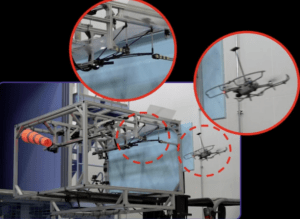
by DRONELIFE Staff Writer Ian J. McNabb
This article published in collaboration with JUIDA, the Japan UAS Industrial Development Association.
Sendai-based Tohoku University’s Tough Cyber-Physical AI Research Center recently announced that their patented multi-drone landing technology “EAGLES Port”, (which stands for Efficient Aerial vehicle Guide with Landing Loading Leaving Enabling Systematic Port, significantly improved landing in wind-tunnel testing at the Fukushima Robot Test Field, demonstrating the effectiveness of this innovative horizontal drone landing method.
As opposed to the more common vertical landing method, (better known as VTOL, or vertical takeoff and landing), EAGLES Port utilizes a horizontal approach via a dockable hanger that slides onto a rail, allowing UAVs to maintain their flight momentum and making them significantly more resistant to adverse atmospheric conditions. Drones fly into a slot, allowing them to “cut through” the wind, whereas many vertical drones are buffeted around and can struggle to land cleanly in less-advantageous weather.

The new system’s benefits are clear- when compared to vertical landings, EAGLES Port landings were approximately 35% faster, and multiple drones could land simultaneously even on a single unit, greatly decreasing the required landing zone. While this kind of technological development might not become an industry standard for individual drone units, due to its increased infrastructure complexity, many currently docked drones being used in a swarm configuration may benefit from access to a more efficient landing method, increasing the potential range of conditions that drones can operate in while also serving as a space-saver for fleet applications such as drone signage or in a security environment.
Indeed, the initial proposal, released in 2020, theorizes that drone landings could eventually be up to 7.5x more efficient via an EAGLES Port than traditional VTOL methods. The system utilizes a cone-shaped entry gate that the drone, (featuring a top-mounted hanger), aims for, which funnels the hanger into a rail that the drone can then move along, potentially aiding delivery operations. Compared to many existing docking solutions, it’s significantly cheaper and easier to install, increasing its scalability and viability to handle growing volumes of UAV traffic.
The press release, announcing the results, is available here (in Japanese).
Read more:
- Wingcopter and ITOCHU Advance Drone Delivery in Japan with New Certification Process
- Japanese Drone Industry Rallies for Earthquake Recovery Efforts
- SkyDrive, Japanese eVTOL Trailblazer, Propels Global Influence with Strategic Gujarat Partnership and Suzuki Investment
- Kawasaki Heavy Industries Tests Unmanned K-RACER-X2 VTOL for High-Altitude Deliveries in Japan’s Mountainous Regions

Miriam McNabb is the Editor-in-Chief of DRONELIFE and CEO of JobForDrones, a professional drone services marketplace, and a fascinated observer of the emerging drone industry and the regulatory environment for drones. Miriam has penned over 3,000 articles focused on the commercial drone space and is an international speaker and recognized figure in the industry. Miriam has a degree from the University of Chicago and over 20 years of experience in high tech sales and marketing for new technologies.
For drone industry consulting or writing, Email Miriam.
TWITTER:@spaldingbarker
Subscribe to DroneLife here.